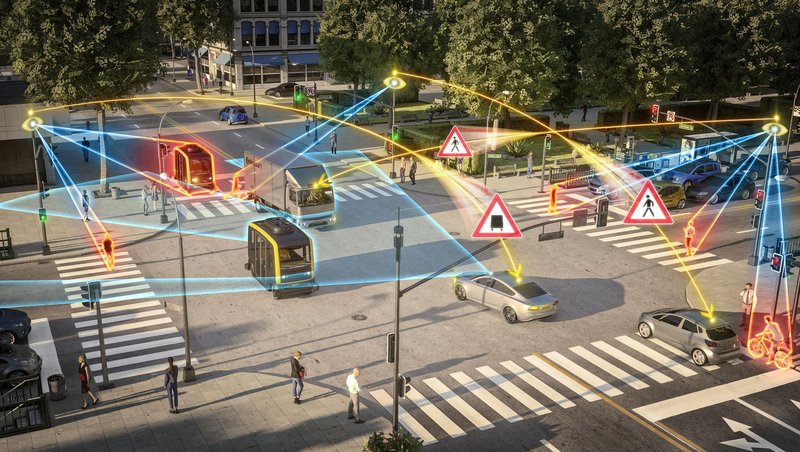Continental Continues Efforts to Make Cities Safer Through Intelligent Infrastructure Technology
- New Smart City Mobility and Transportation Hub established in smart city pioneer, Columbus, Ohio
- Data collected from Auburn Hills Hub used to continue improving algorithms and user interface technology
- Vehicle-to-everything technology critical to achieving Vision Zero
AUBURN HILLS, Mich., November 16, 2020. Technology company Continental continues to make strides in creating safer, smarter cities, an important component to the company’s Vision Zero mission: eliminate traffic fatalities, injuries and crashes. The company has added its second Smart City Mobility and Transportation Hub in a city dedicated to leading the way in mobility innovation: Columbus, Ohio. Currently in its first phase of development, Continental’s Columbus Hub is comprised of two busy intersections with high vehicle and pedestrian traffic made intelligent by integrating Continental sensors, connectivity and intelligent software into the infrastructure.
“As a long-time expert in automotive safety and connectivity, Continental continues to find new ways to deploy that expertise and technology to help make roads safer and mobility smarter for all traffic participants,” explained Tamara Snow, head of Research and Advanced Engineering, Continental North America. “Continental’s intelligent intersection solution gives cities greater visibility into traffic patterns, with future phases designed to help improve traffic flow, reduce pollution and, most importantly, increase the intersection’s safety.”
Through its 2016 partnership with the U.S. Department of Transportation Smart City Challenge, Continental made an initial pledge of at least $1 million to the winning city of Columbus to provide advanced sensing, vehicle-to-everything (V2X) and infrastructure-to-vehicle (I2V) communication technology. Deployed at the intersections of Goodale Street and High Street, and Cleveland Avenue and Fifth Avenue Continental’s solution uses radar and data visualization to give a clear picture of pedestrian and vehicle traffic patterns, uncovering potential opportunities for traffic flow and safety improvements. In the future, the system will be able to detect and broadcast object data information, including intersection traffic participants, to connected vehicles and pedestrians. This is a critical benefit given that more than 50 percent of total fatal and injury crashes occur at or near intersections, according to the Federal Highway Administration.
“Columbus is focused on improving the lives of its residents through responsive, innovative and safe mobility solutions,” explained Mandy Bishop, Smart Columbus program manager, City of Columbus. “Through forward-thinking partnerships like this one with Continental, Columbus is continuing its mission to become model for connected cities of the future.”
Currently focused on collecting and sharing traffic data, Continental’s intelligent infrastructure is identifying key zones and traffic scenarios. One such function, Vehicle Group Detection, counts the number of single vehicles approaching the intersection to determine if a green traffic light should be extended, eliminating unnecessary braking or acceleration. When connected with a traffic light controller, this data can be used to adjust the traffic light timing between connected intersections in real-time to help improve traffic flow, reduce congestion and pollution, and contribute to a safer and more seamless intersection.
In the future, the data currently being collected is planned to enable active safety benefits, including V2X communication, and pedestrian and bicyclist detection. Using V2X technology, the intersection will broadcast safety messages to connected vehicles and pedestrians in and around the intersection. Object data generated by the intelligent infrastructure and broadcasted to all surrounding traffic participants helps visualize vulnerable road users such as visibly obstructed pedestrians to all connected vehicles. This type of communication would make it possible to warn an approaching vehicle about occluded hazards such as pedestrians, a critical safety advancement as 2019 has seen the highest number of pedestrian fatalities since 1988, according to the Governors Highway Safety Association.
Continental is also building a dashboard where all collected data can be visualized for city officials. This dashboard will help the city monitor the overall system, can enable over-the-air updates for new feature deployments and system maintenance, and will ultimately give a previously unseen look into traffic patterns and critical moments, like near-miss crashes and vulnerable road user behavior, that can be used to improve safety and increase efficiency.
Using existing data to improve algorithms
In 2019, Continental launched its first Smart City Mobility and Transportation Hub across two intersections in Auburn Hills, Michigan. Data continues to be collected at those intersections and is being used to further calibrate an environment model needed to deploy V2X and I2V communication. Additionally, the company started testing highly automated vehicles in the intersections, leveraging the data to continue to integrate and implement V2X information to help improve the safety and reliability of automated vehicles when navigating the complex scenarios often found in intersections. These advanced features and functions also include pedestrian detection.
“It has been incredibly beneficial to learn from our findings in Auburn Hills while we continue work in Columbus,” Snow added. “As a data-driven company, we are constantly analyzing incoming information to modify our algorithms and approach to improve intersection safety.”
The importance of the 5.9 GHz Spectrum
Continental is committed to perfecting and deploying V2X technology due to its life-saving potential. In order to be deployed on a large scale and to make the biggest safety impact, V2X technology requires a dedicated radio spectrum, and the 5.9 GHz spectrum has been earmarked for just that. The lifesaving promise of V2X is vast, with the U.S. Department of Transportation stating that V2X technology has the potential to address approximately 80 percent of unimpaired vehicle crashes. Additionally, roadway injuries and fatalities do not only include people inside the vehicle. According to the National Safety Council, in the United States approximately 30 percent of all road fatalities are vulnerable road users, which include pedestrians, cyclists, scooters and motorcyclists. With a dedicated 5.9 GHz spectrum to sufficiently support broad V2X deployment, major strides can be made toward achieving Vision Zero.

Mary Arraf
Head of Communications Automotive and Continental North America

